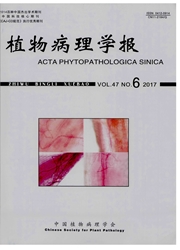

 中文摘要:
中文摘要:
以接种3个SMV株系后分别表现无症状、花叶和坏死症状的大豆品系浙A8901为材料,研究3类症状叶片的生理指标差异,包括细胞超微结构、H2O2积累、水杨酸(SA)含量、光合作用及细胞病毒含量。结果表明:无症状叶片细胞中除叶绿体片层结构轻微扭曲外,其它细胞结构未见异常;CeCl3标记H2O2电镜观察,发现H2O2仅在细胞壁外侧少量积累;在接种1d后SA含量较对照显著升高。花叶症状叶片细胞中出现髓鞘状结构和多泡体结构,核膜边缘有染色质凝集现象;细胞壁外侧观察到较多H2O2的积累;SA含量在接种后第2 d较对照显著增加。坏死症状叶片中细胞变形严重,细胞器解体,在细胞壁外侧和细胞质中均观察到H2O2的大量积累;接种后第2 d SA含量较对照显著增加。三类症状叶片的光合速率、最大光能转化效率(Fv/Fm)和实际光量子效率(ΦPSⅡ)的测定发现,与对照相比均无显著变化。
 英文摘要:
英文摘要:
In this study, the soybean strain ZheA8901 that showed symptomless, mosaic and necrosis induced by three different strains of soybean mosaic virus, respectively, was used for subsequent analysis. The physiolo-gical changes including cell ultrastructure, H2O2 deposition, salicylic acid (SA) contention, photosynthesis and viral concentration during viral infection were characterized. Results showed that the chloroplast lamellas were distorted in the cells derived from symptomless plants, whose H2O2 accumulation was observed only outside of the cell wall. The SA content significantly increased 1 dpi compared to the control. For the cells showing mosaic symptoms, myelin-like structures and the multivesicular bodies were observed and chromatin condensation showed at the periphery of nuclear membrane. A large amount of H2O2 accumulated outside the cell wall, and the SA content substantially increased at 2 dpi. For cells derived from leaves displaying necrotic symptoms, organelle disintegration occurred and a large amount of H2O2 accumulated both inside and outside the cells, and the SA content significantly increased at 2 dpi. The photosynthetic rate, the maximum photochemical efficiency (Fv/Fm) and actual photochemical efficiency (ΦPSⅡ) did not change significantly compared to the control among the leaves with different symptoms.
 同期刊论文项目
同期刊论文项目
 同项目期刊论文
同项目期刊论文
 期刊信息
期刊信息
